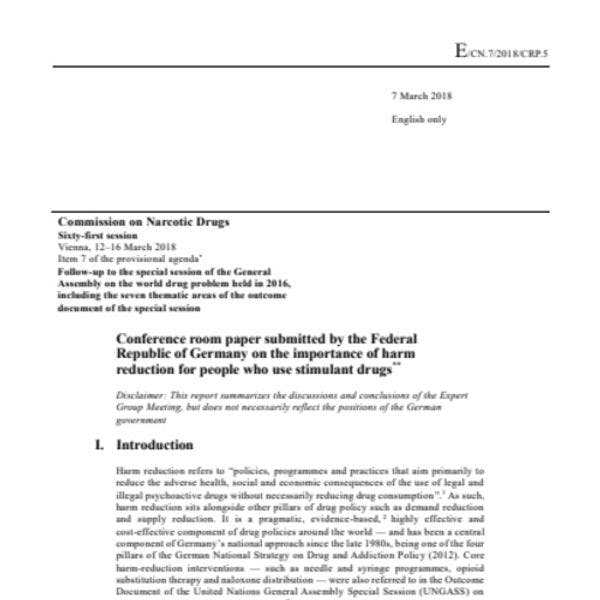Documento de sesión presentado por la República Federal de Alemania sobre la importancia de la reducción de daños para las personas que usan drogas estimulantes
Este documento identifica las barreras principales y los enfoques más novedosos con respecto a la reducción de daños para las personas que usan drogas estimulantes, y formula recomendaciones sobre posibles vías de avance. Más información, en inglés, está disponible abajo.
Harm reduction refers to “policies, programmes and practices that aim primarily to reduce the adverse health, social and economic consequences of the use of legal and illegal psychoactive drugs without necessarily reducing drug consumption”. As such, harm reduction sits alongside other pillars of drug policy such as demand reduction and supply reduction. It is a pragmatic, evidence-based, highly effective and cost-effective component of drug policies around the world — and has been a central component of Germany’s national approach since the late 1980s, being one of the four pillars of the German National Strategy on Drug and Addiction Policy (2012). Core harm-reduction interventions — such as needle and syringe programmes, opioid substitution therapy and naloxone distribution — were also referred to in the Outcome Document of the United Nations General Assembly Special Session (UNGASS) on the World Drug Problem in April 2016.
The Global Partnership on Drug Policies and Development (GPDPD) is a programme implemented by the Deutsche Gesellschaft für Internationale Zusammenarbeit (GIZ) GmbH on behalf of the German Federal Ministry for Economic Cooperation and Development (BMZ) and under the political patronage of the Federal Government’s Drug Commissioner. Under the auspices of this Partnership, an Expert Group Meeting (EGM) on harm-reduction responses for people who use stimulant drugs was held from 4th to 6th October 2017 in Bangkok, Thailand. EGM was co-hosted by the Thai Office of the Narcotics Control Board (ONCB), the International Drug Policy Consortium (IDPC), the Transnational Institute (TNI) and Harm Reduction International (HRI). It brought together 52 participants from around the world, comprising representatives from Member States, United Nations agencies, civil society as well as academics, and people who use drugs. This was the second EGM on harm reduction within the framework of GPDPD, following a first Meeting in Berlin in 2016 whose results were fed into the UNGASS 2016 preparation process.
Over recent decades, the consumption of stimulant drugs has proliferated: according to the United Nations Office on Drugs and Crime (UNODC), 37 million people used amphetamines and prescription stimulants in 2015, and 17 million used cocaine — placing this category of drugs second only to cannabis. The exponential growth in stimulant use presents new challenges to the practice and principles of harm reduction, which have gained prominence over the last 30 years with a focus on opioid use, the injection of drugs and the transmission of HIV and other blood-borne diseases. EGM sought to discuss and explore how harm reduction could be better applied to protect the health of people who use stimulant drugs, within a human rights framework in line with the UNGASS Outcome Document Chapter IV.
This conference room paper outlines the most relevant findings of the Expert Group Meeting.
